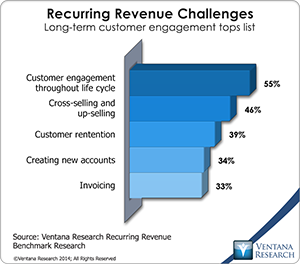The digital economy has changed the way many companies provide products. Some no longer deliver packaged products but provide them as services over a network, typically the Internet. Telecommunications providers in particular are familiar with this business model and have developed processes and systems that use innovations such as product bundles that include elements of fixed charges (such as cost of installation) and variable charges based on usage (such as the number of calls made) and means of registering customers on the network, collecting usage data, invoicing and collections. This  model has been adopted increasingly by the software industry, replacing a single license fee and maintenance charges for on-premises products with software as a service in which users access products over the Internet and pay per user and/or for usage. Adoption of this model by other types of business has led them to think of customers as subscribers.
model has been adopted increasingly by the software industry, replacing a single license fee and maintenance charges for on-premises products with software as a service in which users access products over the Internet and pay per user and/or for usage. Adoption of this model by other types of business has led them to think of customers as subscribers.
These models disrupt established end-to-end customer relationships, billing processes and customer experience management. The customer relationship changes from a linear to a cyclic model. The linear model essentially consisted of finding customers, closing sales and providing support as and when it was needed. The new model is circular, based on finding customers, agreeing on an initial contract, enabling the service, collecting usage data, billing and providing support on a continuous basis; the overall aim is not just to keep the customer satisfied but to increase usage by selling additional services, extending the lifetime of the initial contract and thus driving up customer lifetime value. In this scheme each interaction involves marketing, sales and support, and quality of service (how well the service meets expected performance criteria); each aspect is likely to have an impact on customer loyalty and thus lifetime value.
The challenges inherent in this model are revealed in our recent benchmark research into recurring revenue.  It finds that customer engagement throughout the customer life cycle is the most common challenge (for 56 percent of participating organization), followed by cross- and up-selling (46%) and customer retention (39%). Of relevance in this context is my perspective on providing excellent customer experience, which requires attention to four customer journeys: across engagement channels, throughout the customer life cycle, across internal business groups and frequently across multiple product lines. A subscription or recurring revenue business model faces all these challenges, especially in coordinating activities across business groups. Most companies are organized into separate business groups, which typically have their own processes, systems, information and target metrics, which are not set to drive up customer value throughout the life cycles of subscribers. For example, a simple invoice inquiry can arrive through any channel and could involve the contact center and the finance and customer service functions. Once an issue is resolved to the customer’s satisfaction, there is an opening to provide information about new options and perhaps get the customer to expand the services used or extend the current contract. Each engagement should thus be treated as an opportunity to increase the lifetime value of customers and to deliver outcomes that both meet customer expectations and business goals.
It finds that customer engagement throughout the customer life cycle is the most common challenge (for 56 percent of participating organization), followed by cross- and up-selling (46%) and customer retention (39%). Of relevance in this context is my perspective on providing excellent customer experience, which requires attention to four customer journeys: across engagement channels, throughout the customer life cycle, across internal business groups and frequently across multiple product lines. A subscription or recurring revenue business model faces all these challenges, especially in coordinating activities across business groups. Most companies are organized into separate business groups, which typically have their own processes, systems, information and target metrics, which are not set to drive up customer value throughout the life cycles of subscribers. For example, a simple invoice inquiry can arrive through any channel and could involve the contact center and the finance and customer service functions. Once an issue is resolved to the customer’s satisfaction, there is an opening to provide information about new options and perhaps get the customer to expand the services used or extend the current contract. Each engagement should thus be treated as an opportunity to increase the lifetime value of customers and to deliver outcomes that both meet customer expectations and business goals.
It is not unusual that a significant percentage of a company’s customers are dormant – that is, they buy a product and, if there are no issues, are unlikely to engage further. One of the advantages of a recurring revenue model based on usage is  that companies can track which subscribers are active and which are dormant, which are making most use of the service and which are not using their full allowance, and which have high costs of service. The method for which to accomplish this is through analytics that are Recurring Revenue Benchmark found was the most important technology to use in 82 percent of organizations. Using advanced analytics systems companies can use such data to determine actions that can increase customer value or point out potential closing of the contract. The connected world of digital devices known as the Internet of Things is likely to motivate more companies to adopt a recurring revenue model for their products. In such cases companies should pay particular attention to the impact such models have on the long-term subscriber relationship and make sure they have appropriate processes, systems and metrics in place to maximize customer lifetime value.
that companies can track which subscribers are active and which are dormant, which are making most use of the service and which are not using their full allowance, and which have high costs of service. The method for which to accomplish this is through analytics that are Recurring Revenue Benchmark found was the most important technology to use in 82 percent of organizations. Using advanced analytics systems companies can use such data to determine actions that can increase customer value or point out potential closing of the contract. The connected world of digital devices known as the Internet of Things is likely to motivate more companies to adopt a recurring revenue model for their products. In such cases companies should pay particular attention to the impact such models have on the long-term subscriber relationship and make sure they have appropriate processes, systems and metrics in place to maximize customer lifetime value.
Regards,
Richard J. Snow
VP & Research Director












